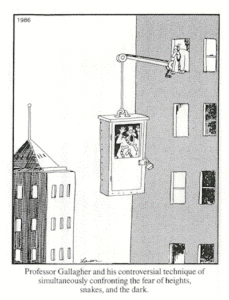Implosion therapy, a behavioral fear exposure therapy technique, in my estimation is the most powerful though poorly understood therapy for addressing fears, phobias, PTSD and a host of other presenting symptoms and concerns. As a graduate student at Binghamton University, I had the good fortune to work closely with Dr. Don Levis, who, along with Dr. Thomas Stampfl, developed and researched this treatment modality. Implosion therapy was a carefully and painstakingly developed following a long duration of basic and clinical research. For those interested in this kind of thing, Implosion was developed by extrapolating from Dr. O.H. Mowrer’s Two-factor fear theory as well as serial CS conditioning experiments.
Implosion differs from flooding in a couple of important ways. Whereas flooding is often done in vivo (real life), implosion is always done in imagery. In flooding, the cues that are presented have a obvious association with the feared or avoided situation. In implosion, while those cues are employed, other so called “hypothesized cues” are also presented that might draw upon a wide range of factors that may influence the emergence of anxiety. An implosion therapist may present cues derived from psychodynamic or other realms.
I personally draw heavily upon “attachment theory”. Remember the little sea turtles from earlier posts? In my view, much of human anxiety stems from our most elemental fears stemming from our special vulnerability stemming from our long dependency upon our primary care givers when we were infants. Thus, much of our anxiety in this view is predicated in our fears of abandonment and rejection which is tantamount to death and separation.
Implosion therapy can be used not only with anxiety, but to help expose cues associated with and avoided emotional experience. It is also used to help people face difficult memories and traumatic occurrences.
I implosion therapy, an individual is asked to imagine scenes that incorporate the most obvious, as “hypothesized” cues that may be associated with a particular fear or other emotions. So for example, a person with a irrational preoccupation with germs might be asked to imagine being covered with germs as well as cues associated with disease, death, loss of personal control etc.
For an individual with public speaking, they may be led into scenes of being unable to perform in an important meeting, and they are reduced to a blubbering mass. This in turn incurs negative judgement and derision among the onlookers.
In the book, I provide a template for how to write and direct your own internal horror movies with the purpose of maximally exposing those cues that are personally relevant to you. In the next post, I will share some of the most essential factors to incorporate into your own implosion scenes.
Everyone is invited to post comments, thoughts, experiences







7 Comments. Leave new
I think the best way to treat a client that surfer from irrational fear is via practical exposure of the stimulus.
It is surely not the most powerful therapy for fears and phobias. Flooding with in vivo stimulus is
This was quite helpful as I was doing an assignment on flooding and implosion
Pls can you write more articles on aversion and assertive therapy
I have found implosion to be very effective in phobias but not in cognitive induced anxieties
I am not sure what a “cognitive induced anxiety is”. Thoughts do not cause anxiety on their own without some unconditioned stimulus of biological impact being present at some point in an individuals history. Thoughts can serve as conditioned stimuli and thus can mediate a drive state such as fear. For imaginal exposure to be fully effective, the therapist has to have a thorough understanding of the nature of pathological conditioning in humans so as to be able to formulate sound hypotheses that will guide the nature of cues to present in imagery. Often therapists just provide surface or “symptom contingent cues” but not the more subtantial cues that derive their power from their proximity to the real UCS that provoked conditioning. Keep in mind that for most humans, the UCS often has to do with broken primary attachments….the mother of all fears!!!!
BTW Sunday….what a cool name!!!